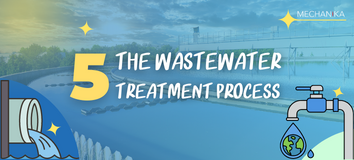The wastewater treatment process involves several stages and technologies aimed at removing contaminants and pollutants from wastewater, making it safe to be discharged back into the environment or reused for various purposes. The process can be divided into primary, secondary, and tertiary treatment stages. Here is an overview of each stage:
- Preliminary Treatment:
-
- Large debris, such as sticks, rags, plastics, and other solid objects, is removed using screens or bar racks.
- Grit, like sand and pebbles, is settled out in a grit chamber.
2. Primary Treatment:
-
- The wastewater flows into primary settling tanks or clarifiers.
- Heavy solids, organic matter, and some suspended solids settle at the bottom, forming primary sludge.
3. Secondary Treatment (Biological Treatment):
-
- The partially treated wastewater is transferred to aeration tanks or basins.
- Oxygen is supplied to support the growth of aerobic bacteria that consume organic matter and nutrients in the wastewater.
- This biological process reduces the levels of organic pollutants.
4. Secondary Clarification:
-
- After the biological treatment, the mixture of treated wastewater and activated sludge flows into secondary clarifiers.
- The activated sludge settles at the bottom, and the clarified water is separated and ready for further treatment.
5. Tertiary Treatment (Advanced Treatment) – Optional:
-
- Additional treatment steps, depending on the required effluent quality and regulations.
- Filtration: Passing the water through sand or multimedia filters to remove remaining fine suspended solids.
- Disinfection: The water is disinfected to kill harmful bacteria and pathogens using chlorine, UV light, ozone, or other methods.
- Nutrient Removal: If needed, additional processes are used to reduce nitrogen and phosphorus levels in the water to protect receiving water bodies from nutrient pollution.
6. Sludge Treatment:
-
- Sludge generated from primary and secondary treatment is collected.
- Sludge undergoes further treatment, such as thickening, digestion (anaerobic or aerobic), and dewatering.
- The treated sludge can be used for land application, incineration, or disposed of in a landfill.
7. Discharge or Reuse:
-
- The treated water, known as effluent, is discharged into receiving water bodies like rivers, lakes, or oceans, or it can be reused for non-potable purposes like irrigation, industrial processes, or groundwater recharge.
It’s essential to note that wastewater treatment systems can vary in complexity and the specific processes used, depending on the scale of the plant, the quality of the incoming wastewater, and the regulatory requirements in the region. The overall goal is to treat the wastewater effectively to protect the environment and public health.

